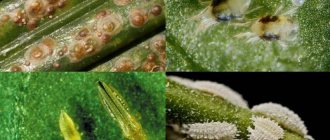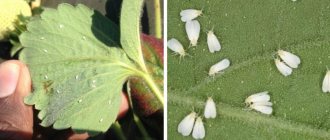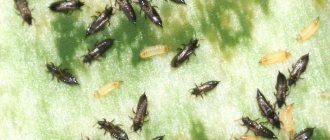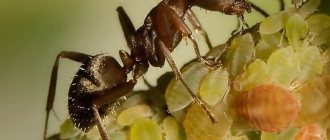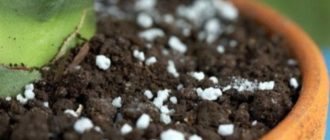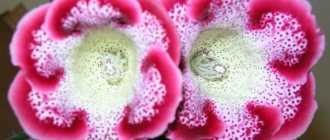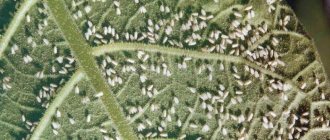Spider mites on indoor plants, how to fight? – many fans of growing fruits at home ask themselves. In the modern world, people are increasingly planting flowers and shrubs at home. This cleans the air, absorbs carbon dioxide and creates a beautiful atmosphere in your home.
Unfortunately, this has its drawbacks in the form of harmful insects that destroy all living things. Everyone wants to know how to get rid of them permanently. Today we will talk about exactly this.
Origin of the species and description
Photo: Spider mite
Spider mites belong to the phylum arthropods, class arachnids, subclass mites. These are very small (0.2-1 mm) arthropods that feed on plants. Their sexual dimorphism is well expressed: females are significantly larger than males and have a more rounded body; males are correspondingly smaller and have a more elongated body.
The appearance of adult individuals is characterized by a solid body structure. Their body, unlike larvae and nymphs, is only conditionally segmented, and traces of dismemberment are noticeable only in the arrangement of the setae (Hittites). The bristles perform a tactile function and are arranged in transverse rows. They are very diverse in their shape, depending on where they are located (on the crown, on the back, on the lower back, on the sacrum, on the tail).
Video: Spider mite
There are several types of spider mites:
- ordinary - affects almost all types of plants;
- red - feeds on all nightshade crops, as well as citrus fruits;
- hawthorn - lives on fruit trees, both stone fruit and pomaceous (plum, cherry, sweet cherry, peach, sloe, apple, pear, hawthorn);
- Turkestan - a polyphagous parasite that attacks leguminous plants, stone fruit and pome fruit trees;
- cyclamen - lives only indoors or greenhouses, you will not find it on the street; settles on cyclamen, geranium, chrysanthemum, gloxinia, balsam;
- gall - prefers to settle on young leaves, in the process of its life activity it forms peculiar warts (galls) on them;
- root (bulb) - lives inside flower bulbs, feeding on their tissues;
- wide - prefers to settle on citrus fruits, cacti, ficus, Saintpaulia, aucuba;
- false - lives only in greenhouses, very small (0.3 mm), does not spin webs.
Interesting fact: Recently, scientists discovered several species of ticks of the superfamily Tetranychoidea, and among them no males were found.
What kind of insects are these?
These are small arthropods (constituting the class Arachnida) animals with almost 1300 species. Distributed throughout all corners of the Earth, on all classes of plants. They do not pose a danger to people .
What do they look like?
A very small destroyer (from 0.2 to 0.6 mm in size) with a body shaped like an oval.
It is distinguished by a convex upper and flat lower surface of the body, with different colors. It can be very diverse and vary in contrasting colors - from yellow or green, to gray, bright red, burgundy or black. It may even be colorless (transparent).
Appearance and features
Photo: What a spider mite looks like
The entire body of the spider mite is enclosed in a structured thin or more dense cuticle with folds, points or tubercles. Covers of a denser cuticle can form peculiar shields. The body color of ticks, depending on their species, can be translucent, yellow-green, orange, bright red. Regardless of the color of the body, its internal organs are always visible through the outer covering of the insect in the form of a darker spot.
Adult ticks and nymphs have four pairs of thin legs, while larvae have only three. At the ends of their legs they have complex claw-shaped devices. With their help, mites cling tightly to stems and leaves. The genital organs of female ticks are located on the abdomen, while those of males are located in the back of the body. The mouthparts of these insects are of the piercing-sucking type and are well adapted for quickly piercing the skin of plants and sucking up the secreted juice.
The gland responsible for the production of the web is located on the head (only in females and nymphs) and is located inside short segments (pedipalps), which are fused during the process of evolution. On the second body segment from the head, ticks have four simple red eyes that react exclusively to short waves of the light spectrum.
Now you know what measures are available to combat spider mites. Let's see where this insect lives.
Signs of infection
A tick infestation can be identified by the following signs:
- The presence of a thin cobweb on leaves, stems and flowers.
- “Needle” punctures (bite marks) on flower petals and leaves. These dots enlarge over time and merge, forming a dried-out area of the leaf.
- The leaves have a curled appearance and fall off.
- In good lighting, silvery spots and stripes (mite secretions) are visible.
Where do spider mites live?
Photo: Spider mite in Russia
Spider mites can be found everywhere except Antarctica. After all, the boundaries of their habitat are limited not by climatic zones, but by the average annual temperature, which is plus 4.5°C. More than a hundred species of these insects have been described in Russia alone. When periodic outbreaks of population growth occur, ticks can migrate over quite long distances in search of food. The wind often helps them with this. Hungry mites crawl out to the edges of the leaves and form moving, living balls that are picked up by the wind.
Spider mites are most active in warm and dry weather. During rain and even with a slight increase in humidity, they become inhibited. The thing is that the excretory system of arthropods does not provide for the removal of excess fluid that enters their body with food. Because of this, they stop eating and reproducing, due to the so-called physiological starvation.
In autumn, when the length of daylight hours decreases to 16 hours, most fertilized female spider mites burrow into the ground and enter a special state - diapause. At this time, all their life processes slow down. Since they do not move and do not eat anything, they consume 5 times less oxygen. During this time, the tick's body becomes resistant to sudden temperature changes, excess moisture, and the effects of insecticides.
Folk remedies
Due to the fact that chemicals in most cases are also dangerous for people, many people prefer to use folk remedies. They can also be very effective, especially if the mite has just started on plants.
Garlic infusion
To prepare this simple remedy, you need to infuse 2 heads of garlic in 1 liter of water for 5 days. After this, the liquid must be filtered through cheesecloth and sprayed on the affected plants.
Onion infusion
In this case, you need to steep 2 onions in 1 liter of boiling water for 1 day. After filtering, it is better to dilute the solution with another 1 liter of water in order to reduce the concentration and means and not harm the plant itself during spraying.
Alcohol
For this product you will need ammonia, 3 ml of which must be diluted in 1 liter of water. The plant needs to be sprayed or wiped.
Rubbing alcohol and isopropyl alcohol should not be used. The plant will die from such substances.
Soap solution
To prepare the product, you need to dissolve 25 g of soap in 1 liter of warm water and add 2-3 drops of ammonia. It is best to use tar or boric soap for the product.
Vodka diluted with water
To prepare the composition for spraying, you need to dilute vodka and water in a 1:1 ratio. You cannot increase the concentration, otherwise the plant will get burned.
Dandelion root infusion
To prepare this remedy, you need to very finely chop 30 g of dandelion roots. After this, they must be infused in 1 liter of water for 2 days.
Decoction of cyclamen tubers
To prepare the product in 1 liter of water, you need to boil crushed cyclamen tubers for half an hour. After this, the broth must be covered with a lid and wait until it cools completely. All that remains is to spray or wipe the plant.
Infusion of calendula flowers
You can use dried or fresh calendula flowers. They will need 1 tbsp. The flowers must be poured with 1 liter of boiling water and left until the mixture cools completely. After this, you need to strain the liquid and treat the plants.
Laundry soap
For processing you will need 72% laundry soap. You need to create a thick foam from it and cover the entire plant with it. In this state, the flower must be left for 2-3 hours until the soap is completely dry.
Cinnamon stone
Brownstone is made from cinnamon oil. It is not sold everywhere, but if you managed to buy it, then the treatment must be performed every 3 days for 3 weeks. The product is effective only against adult insects.
What does a spider mite eat?
Photo: Spider mite on a plant
The menu of spider mites consists of the cell sap of various plants. Most often they attack young plants, although in case of acute deficiency (especially at the end of summer or early autumn) they do not disdain older ones. At the tips of their legs, mites have special pointed claws that make many holes on the back of the leaves. Cell sap flows out of these holes, which insects absorb with their mouthparts.
The salivary glands of ticks contain a special aggressive enzyme that destroys chloroplasts (green cells) of plants and partially digests their food. Most often, these arthropods feed on the sap of various grasses and deciduous trees, but occasionally there are lovers of coniferous flora.
Some types of spider mites are polyphagous, that is, they can feed on many types of plants, others are oligophagous (a limited number of plant species, for example, within one family - nightshade, legume, melon, geranium, etc.); still others are monophagous (they live on only one type of plant).
Particularly susceptible to attacks by spider mites:
- cotton;
- melons;
- fruit trees;
- ornamental herbaceous plants in greenhouses, on window sills, in open ground.
What plants does the pest attack?
Spider mites are unpretentious eaters. However, the first on the list of his favorite crops are cucumbers, tomatoes, peppers and pumpkins. Insects also love sweet berries: raspberries, strawberries, currants and grapes. Apple trees, pears and apricots also cannot withstand his destructive interest. And even decorative flowers such as roses, callas, fuchsias and cyclamens cannot safely exist with it in the same area.
Features of character and lifestyle
Photo: Spider mites in the garden
Despite their almost microscopic size, spider mites are truly dangerous pests of both wild and cultivated plants. In a short time they can harm not only home collections of plants, but also large nurseries that are engaged in the industrial cultivation of flowers. Juvenile ticks have three pairs of legs. After two molts, they acquire another pair and become adults - adults. Females live on average from 5 to 40 days.
The most comfortable temperature for the life and development of spider mites is from plus 25-30°C. At this time, their complete development (from egg to adult) takes 7-8 days. When the temperature drops, the development process occurs in 28-32 days. Spider mites typically live on the underside of leaves. There he makes many small holes and sucks out the juice.
Leaves damaged in this way become dehydrated, wither and dry out. Even a minor infestation by these pests can significantly affect the development of a plant. Indeed, with a prolonged attack by mites, the plant’s ability to photosynthesize decreases significantly. And without this important process, plants weaken and may even die.
When daylight hours decrease to 14 hours, only overwintering female pests can develop. Thanks to diapause, they can easily tolerate temperatures dropping to minus 28°C. In spring, when the air temperature rises to plus 12-14°C, female mites wake up, crawl out of the soil and settle on the back of plant leaves, abundantly entwining them with cobwebs.
They also lay eggs here, since they left for the winter already fertilized. The very first thing is that the spring offspring of spider mites develop on quinoa, nettle, and plantain. By mid-July, arthropods gradually move onto cultivated plants.
Methods of disposal
How and with what to save plants from ticks? There are 4 main methods of getting rid of ticks, which include a huge number of means of destruction and repellent .
Chemical
The most radical and effective. Consists of using various chemicals - acaricides .
Conventional insecticides do not work on ticks, as representatives of arachnids.
Among the most popular products are Actellik, Omite, Neoron, Sunmite, Apollo, Nissoran, Demitan, Talstar, Flumite, Fufanon.
Their use can completely eliminate the population of mites and their eggs.
Biological
This is the use of biologically derived products. It is quite diverse and includes:
- The use of natural enemies of vegetarians - predatory mites .
- Placement of plants that repel pests.
- Application of biological acaricides . These include Akarin, Fitoverm, Agravertin, Bitoxibacillin, Vertimek.
Agrotechnical
It only works in combination with other methods, as it involves creating unfavorable conditions for the tick to live.
It helps prevent their occurrence and reduce the population, but does not completely eliminate pests.
People's
It involves using home remedies that can get rid of spider mites. Popular because of its availability, cost-effectiveness and ease of use. The difficulty lies in selecting sufficiently effective remedy; not all drugs work well enough.
To destroy and repel ticks, decoctions, infusions and tinctures of plants, some medications (iodine, potassium permanganate, alcohol, hydrogen peroxide, ammonia solution), food and household products are used.
In our article “Methods and measures to combat spider mites,” the necessary information is given in more detail and detail.
Social structure and reproduction
Photo: Spider mite insect
Spider mites reproduce only under favorable conditions - air temperature above plus 25°C and low humidity (no more than 40%). When the temperature drops and humidity increases, ticks tend (though not always) to enter a short-term diapause or become very lethargic and inhibited. In the tropics and greenhouses, their reproduction can occur continuously throughout the year.
Interesting fact: In 12 months, spider mites can breed up to 20 times.
Fertilization in spider mites occurs without depositing capsules with seminal fluid, but by penetration of the male genital organ into a special hole on the female’s abdomen. Occasionally, fertilization occurs without the participation of male germ cells (virgin).
A fertilized female tick lays her eggs in small groups (1-2-3 pieces), entwining them with a web. Mite eggs have a round shape, somewhat flattened below and above with a smooth, shiny surface of light beige color. There is a thin tail at the top of each egg. The female can lay eggs in a variety of places: on the roots of plants, under fallen leaves, in the soil, on the inside of young leaves and even on the walls of flower pots.
Interesting fact: Under unfavorable conditions, eggs can freeze for 3-5 years, and then resume their development again.
After 3 days, the eggs hatch into larvae, which become nymphs within a day. It takes nymphs 3-4 days to molt and develop stages 1-2. After a week, the nymphs finally molt and turn into fully adult and sexually mature individuals.
Interesting fact: It has been proven that in most species, female ticks hatch from fertilized eggs, and males from unfertilized eggs.
The life cycle of spider mites directly depends on the ambient temperature. For example, at plus 20°C all their development stages pass in 20 days, at plus 25°C - in 10-14 days, at 30-33°C - in just 5-8 days. In this case, the lifespan of spider mites can last 16-30 days. When the daytime temperature drops below plus 18°C, spider mites look for a secluded place and hibernate (diapause).
Preventive measures
Prevention includes the following:
- Digging up the ground near bushes and trees in autumn and spring.
- Collecting fallen leaves.
- Planting repellent plants (onions, garlic, calendula, marigolds, etc.).
- Pruning affected bushes before cold weather.
- Burning affected leaves and stems.
Natural enemies of spider mites
Photo: What a spider mite looks like
Since the spider mite itself is a malicious pest, talking about its natural enemies may seem somewhat inappropriate. However, this parasite also has many natural enemies. In nature, the most important enemy of the spider mite is the predatory mite Phytoseiulus persimilis, which belongs to a special family of parasitic mites Phytoseiidae.
Its homeland is the tropics, from where it was brought to more northern countries quite a long time ago (in 1963). It is very actively used for pest control in large industrial greenhouses and conservatories. The predatory mite parasitizes the body of the spider mite, actually eating it alive.
Two other species of mites also feed on spider mites: Amblyseius and Metaseiulus occidentalis. In northern latitudes, the familiar ladybugs are not averse to hunting pests. Not so long ago, just 10-15 years ago, special soil bacteria Bacillus thuringiensis were discovered that can kill spider mites.
Under natural conditions, they usually do not reach the required concentration that can affect ticks, but in laboratory conditions they do. Today, based on the spores of this bacterium, special biological products are produced that help get rid of spider mites on both a small and larger scale.
Varieties
If you are seriously thinking about how to deal with spider mites on indoor plants, then you should first find out what type they are and can be encountered.
So far, scientists have identified the six most common:
- Standard. First of all, it colonizes the lower leaves, and only then, when the family grows, it begins to infect all living things further, killing almost everything in its path. Usually, fighting it without chemicals is useless.
- Red is a large variety of pest. These individuals reproduce well at high temperatures, which leads to the death of almost everything animate where it settles.
- False is an extremely dangerous type. It is extremely small in size, it does not weave a web and does not leave any traces of its presence, so its arrival will be known only when the fetus inevitably dies.
- Atlantic. It usually infects exotic palms and bushes, but can spread to any other. This species is rare. It multiplies when there is high humidity in the room.
- The cyclamen reptile loves high air moisture. Visually similar to a large layer of dust, so it is often confused with it.
- Wide is one of the easiest parasites to resist. Although eggs are laid every few days, the females do not dive or hide, so it is extremely easy to fight it. Its appearance is immediately noticeable by a large layer of dust. Reviews from people confirm that it is quite easy to remove.


